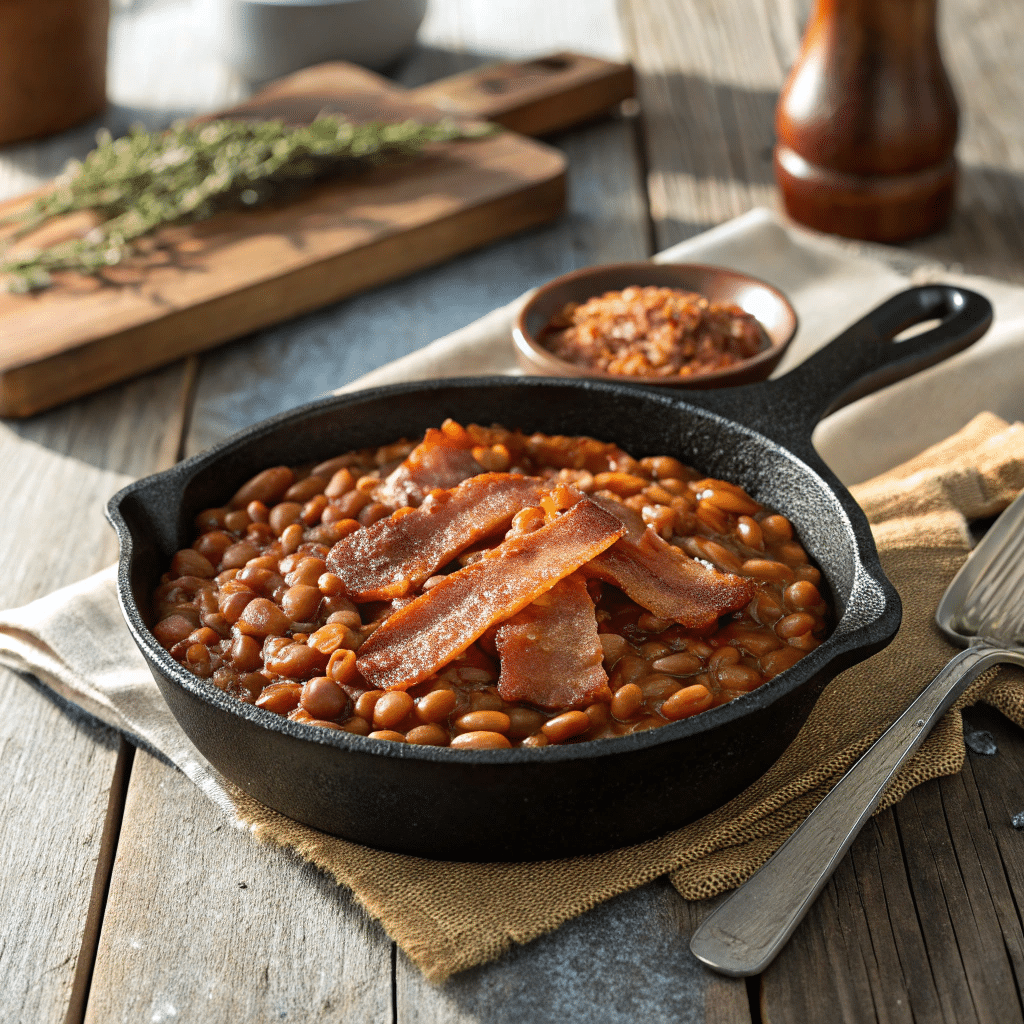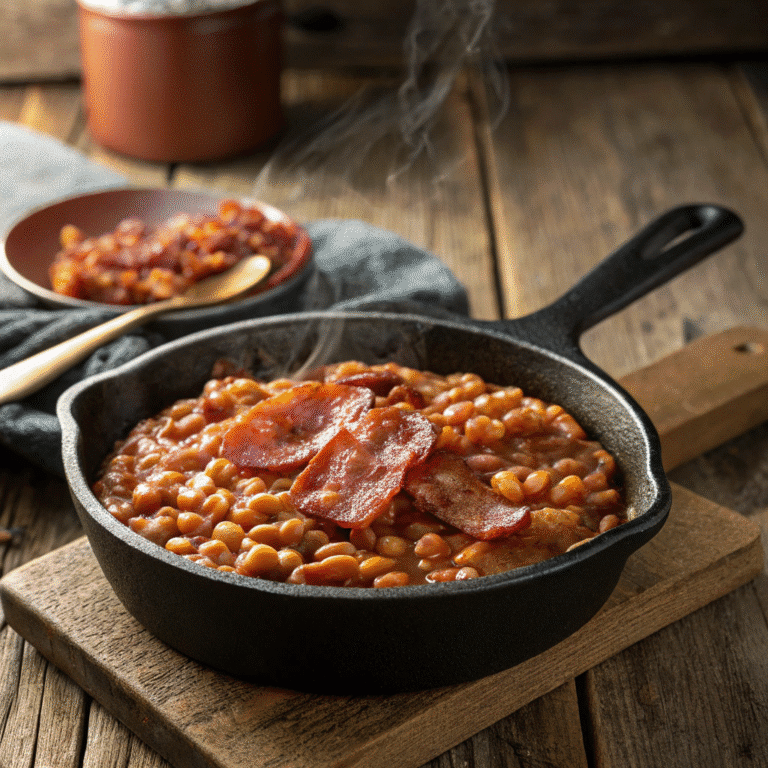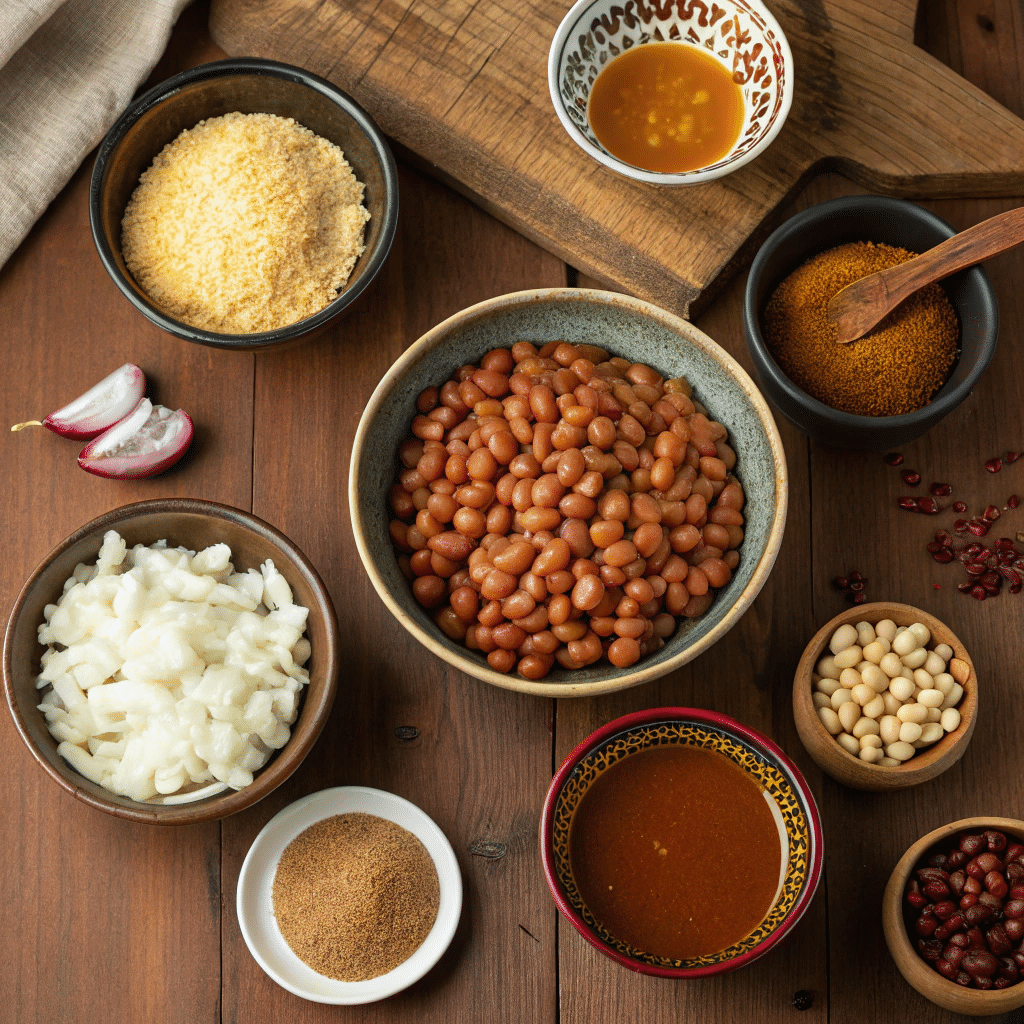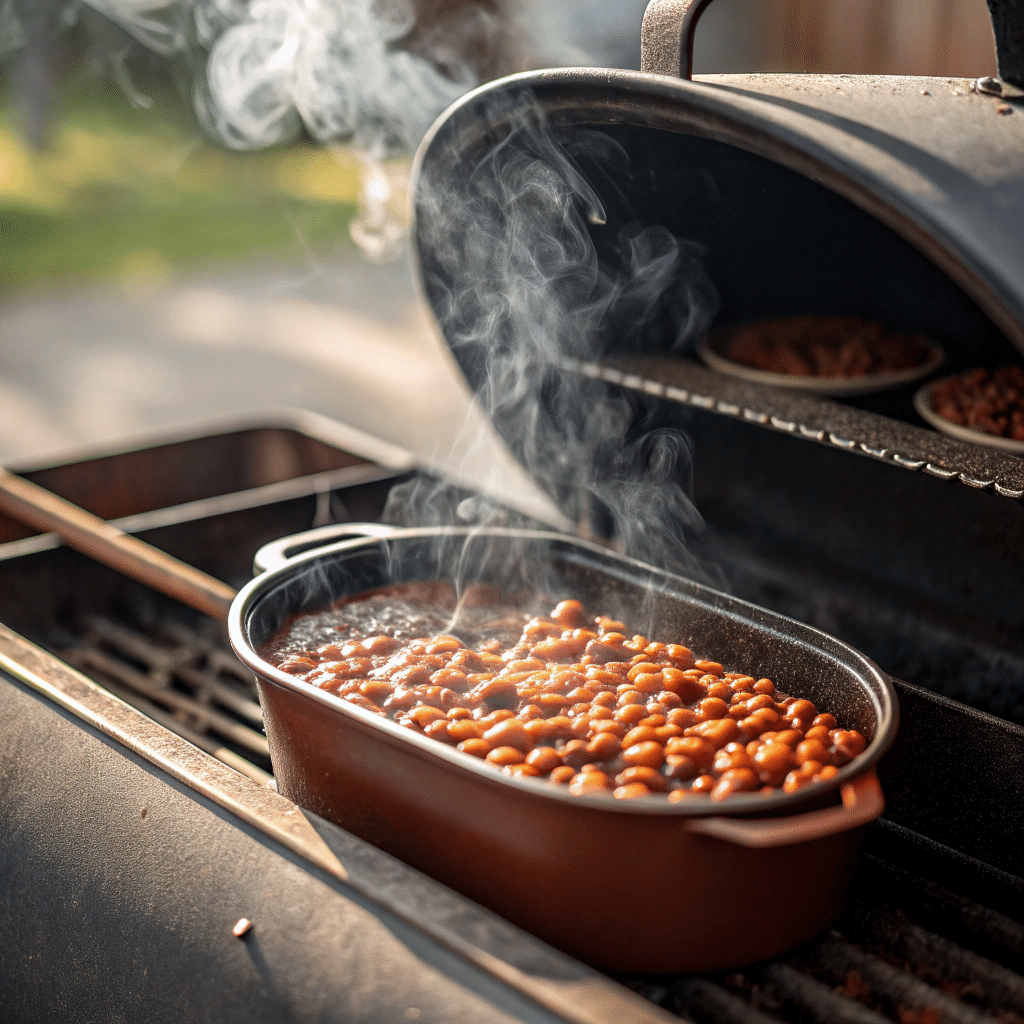If there’s one side dish that always steals the show at my backyard cookouts, it’s smoked baked beans. I’ve been perfecting this recipe for years, and every time I serve it, someone asks, “What’s your secret?” Honestly, there’s just no beating that slow-cooked, smoky flavor blended with the rich sweetness of molasses and a hint of spice. Whether I’m feeding family or hosting a big summer BBQ, smoked baked beans are always on the menu—and they’re always the first dish to disappear.

I love how versatile this recipe can be. Sometimes I start with dry beans from scratch, and other times I grab canned baked beans and just focus on building flavor through low-and-slow smoking. Either way, the results are always mouthwatering. From choosing the right type of wood and meat pairings to experimenting with spicy or sweet flavor combos, I’ve learned a lot about what makes smoked beans unforgettable.
Print
Smoked Baked Beans
These smoky, sweet, and savory smoked baked beans are the ultimate BBQ side dish. Infused with real wood smoke and topped with crispy bacon, they’re easy to prep and perfect for cookouts, potlucks, or weeknight comfort food.
- Total Time: 2 hours 35 minutes
- Yield: 8 servings 1x
Ingredients
2 cans (15 oz each) navy or pinto beans, drained
6 slices thick-cut bacon, chopped
1 small yellow onion, finely chopped
⅓ cup molasses
¼ cup brown sugar
2 tbsp yellow mustard
¼ cup ketchup
2 tbsp apple cider vinegar
1 tbsp Worcestershire sauce
1 tsp smoked paprika
Salt and black pepper to taste
Instructions
Preheat smoker to 250°F using hickory or applewood for a balanced smoky flavor.
Cook bacon in a skillet until slightly crisp. Remove and set aside.
Sauté onion in bacon fat until translucent (about 4–5 minutes).
In a large foil or cast iron pan, combine beans, sautéed onion, cooked bacon, molasses, brown sugar, mustard, ketchup, vinegar, Worcestershire, and paprika. Mix well.
Place pan in smoker, uncovered. Smoke for 2 to 2.5 hours, stirring once halfway through.
Check consistency near the end. Add a splash of water if beans get too thick.
Remove from smoker and let rest 10 minutes before serving.
Notes
For spicier beans, add 1 chopped jalapeño or ½ tsp cayenne.
Sub brisket or pulled pork in place of bacon for a meatier variation.
Store leftovers in an airtight container for up to 4 days, or freeze up to 3 months.
- Prep Time: 20 minutes
- Cook Time: 2 hours 15 minutes
- Category: Side Dish
- Method: Smoking
- Cuisine: American BBQ
- Diet: Gluten Free
Nutrition
- Calories: 285 kcal
- Sugar: 16g
- Sodium: 540mg
- Fat: 9g
- Saturated Fat: 3g
- Unsaturated Fat: 5g
- Carbohydrates: 39g
- Fiber: 7g
- Protein: 11g
- Cholesterol: 15mg
In this guide, I’ll show you how to make the best smoked baked beans you’ve ever had. I’ll walk you through the ingredients, step-by-step prep, and even tips for smoking canned beans (spoiler: it works like a charm). I’ll also answer common questions like why Brits love beans for breakfast, and which meats bring out the boldest BBQ flavor.
Check out How to Smoked Chicken Thighs Perfectly Every Time to complete your BBQ spread with a smoky, tender protein that pairs beautifully with baked beans.
Table of Contents
What Are Smoked Baked Beans?
History of Baked Beans and Their BBQ Evolution
I’ve always been fascinated by the roots of traditional comfort food, and baked beans are no exception. Originally, baked beans trace their roots back to Native American cooking. Tribes would cook beans slowly with maple syrup and bear fat in clay pots—talk about deep flavor! When European settlers embraced the dish, they transformed it by incorporating salted pork and molasses, a distinctive evolution that eventually led to the creation of today’s iconic Boston baked beans.
Jump ahead to today’s BBQ scene, and baked beans have taken on a whole new level of flavor—transforming into irresistibly smoked baked beans. This version takes everything we love about the original—sweetness, richness, texture—and kicks it up a notch with wood smoke, spice, and sometimes even meat. Over the years, pitmasters and backyard grill enthusiasts like me have elevated this simple dish into a smoky companion that stands proudly alongside brisket, ribs, and pulled pork.
What I appreciate the most is its incredible versatility. Whether you prefer Southern-style beans with brown sugar and bacon, or want to spice things up with jalapeños and hot sauce, the smoker enhances everything. Smoking isn’t just a cooking method—it’s a flavor strategy.
How Smoking Enhances Flavor in Baked Beans
If you’ve never tried smoked baked beans before, you’re seriously missing out. When beans are cooked slowly over gentle heat with hickory, applewood, or mesquite, they absorb the smoky flavors deeply, like a sponge soaking up water. That’s what gives them their rich, deep flavor—earthy, savory, and just a little bit sweet.
The smoke not only adds complexity, it also binds all the ingredients together in a way that oven-baked beans simply can’t replicate. I usually keep the smoker temperature around 225–250°F and let the beans sit uncovered for at least two hours. This way, the smoke infuses every bite while reducing the sauce to a thick, glossy glaze.
For even more depth, I often add a handful of chopped smoked brisket or pulled pork into the mix. The blend of savory meatiness and smoky beans creates a flavor experience that’s truly extraordinary.
Ingredients for the Best Smoked Baked Beans
Choosing the Right Type of Beans (Canned vs. Dry)
When I first started making smoked baked beans, one of the biggest choices I had to make was whether to use canned or dried beans. Let me tell you—both options work great, depending on how much time you have.

Canned beans are the obvious time-saver. I typically go for canned navy or pinto beans with no added flavors. They’re soft enough to absorb smoky goodness without turning mushy, and they don’t require soaking or boiling.
On the other hand, if I’ve got time to plan ahead, dried beans give you more control over texture and flavor. Just soak them overnight, simmer until tender, and they’re ready for the smoker. Whether canned or dry, the real magic happens in the seasoning.
No matter which bean you choose, make sure they’re firm enough to hold up during smoking. You don’t want your smoked baked beans turning to soup.
Key Flavor Boosters: Molasses, Mustard, Onions & More
Here’s where it gets fun—the flavor mix. Every time I make a batch of smoked baked beans, I start with a simple but powerful combo: chopped onions, brown sugar, yellow mustard, apple cider vinegar, molasses, and Worcestershire sauce. It’s sweet, tangy, rich, and deeply satisfying.
Want some heat? I’ll toss in diced jalapeños or a dash of cayenne. Like it meaty? A few strips of thick-cut bacon or a scoop of pulled pork adds a savory edge that balances the sweetness.
I always recommend tasting as you go. Your smoker will naturally intensify the sauce, so it’s best to go easy on the salt and sugar at the start. Smoke brings out intense flavors, and you want your beans to shine—not overwhelm.
Discover great ideas like Smoked Beef Roast: How To Make A Tender At Home for adding smoky meat directly into your bean mix.
Choosing the Right Smoker & Wood for Beans
Best Types of Smokers for Baked Beans
When I first tried smoking baked beans, I used my old offset smoker—and honestly, it worked like a charm. But since then, I’ve tested everything from pellet smokers to electric models, and the truth is, most smokers can handle smoked baked beans. You just need steady, indirect heat.
If you’re working with a charcoal smoker, set it up for low and slow cooking at 225–250°F, and place the beans in an uncovered foil pan to let the smoke work its magic. For pellet grills, just pick your wood pellet flavor, set the temp, and go. Even a basic vertical smoker works fine for this recipe—just make sure you have a drip tray to catch any sauce.
No matter the smoker, always use a pan that allows enough surface area for smoke to circulate. That’s how you get that deep, wood-fired flavor in your smoked baked beans.
Top Smoking Woods: Hickory, Applewood, Mesquite
Let’s talk wood. For a bold, BBQ-style taste, I go with hickory. It delivers that rich, smoky depth that people crave in classic smoked baked beans. Want something a little sweeter? Applewood adds a light, fruity note that balances spicy or tangy ingredients.
Mesquite is stronger—more intense. I tend to use it sparingly or blend it with oak to balance and mellow the intensity. Too much mesquite can overpower the beans. Cherry and pecan woods also work beautifully if you want something in the middle—sweet, but earthy.
Experiment with blends and see what fits your flavor style. Just make sure the smoke complements your bean base and any meats you’ve added.
How to Prepare Smoked Baked Beans from Scratch
Step-by-Step Instructions (Soaking, Cooking, Seasoning)
When I’m prepping smoked baked beans from scratch, I always start with dried navy beans. I soak them overnight, then boil them just until tender—not mushy. That way, they maintain their shape while still absorbing all that smoky goodness during the cook.

Here’s my simple prep method:
- Soak: 1 pound of beans in water overnight.
- Boil: After draining, simmer the beans for around 45 minutes until they’re tender but still hold their shape.
- Season: In a large foil pan, I mix the beans with sautéed onions, garlic, brown sugar, molasses, yellow mustard, ketchup, and a splash of apple cider vinegar.
- Add meat (optional): Chopped bacon or smoked brisket gives the beans a rich depth.
- Smoke: I set the pan in my smoker at 250°F, leaving it uncovered for 2 to 3 hours to let the beans soak up that rich, smoky flavor.
That’s it! Stir occasionally to prevent burning, and let that smoke work its magic.
How Long Should You Smoke Canned Baked Beans?
If I’m using canned beans (and I often do when I’m short on time), I follow the same method—minus the soaking and boiling. Just drain excess liquid, mix with your flavor base, and smoke them low and slow for 1.5 to 2 hours.
The key with smoked baked beans is patience. Letting the sauce reduce and thicken naturally inside the smoker adds a deep, sticky richness that oven baking just doesn’t match.
Crafting Killer Baked Beans: Bold Sweet & Spicy Twists
How to Make Wicked Baked Beans with Bold Flavors
When I’m aiming to turn up the flavor, I whip up what I like to call “wicked” smoked baked beans—sweet, spicy, smoky, and seriously crave-worthy. The key? Balance. The heat should enhance the sweetness, not overpower it..
I begin with a foundation of brown sugar and molasses, then fold in chopped jalapeños, a pinch of cayenne, and smoked paprika. Every now and then, I mix in chipotle in adobo to bring a deeper, smoky heat that sticks around just right.
If you’re craving extra heat, go bold—throw in some chopped habaneros or a dash of your favorite hot sauce. But always balance it with something sweet, like honey or maple syrup. That sweet-spicy contrast is what makes wicked smoked baked beans stand out.
Top Spice Blends and Regional Variations
Everyone has their own twist. Down South, it’s common to find beans packed with hot sauce, tangy mustard, and savory sausage. In the Midwest, folks love adding BBQ rubs and bits of smoked pork.
Here are a few combos I love:
- Tex-Mex Flair: Incorporate cumin, chili powder, black beans, and sweet corn.
- Maple Bacon Kick: Combine maple syrup, mustard, and hearty thick-cut bacon.
- Carolina Fire: Mix tangy vinegar, red pepper flakes, and tender pulled pork.
Whichever way you go, just keep tasting. Beans are forgiving—you can tweak the flavors as you go until everything hits the perfect balance.
Best Smoked Meats to Pair With Baked Beans
What Meats Work Best: Brisket, Pulled Pork, Sausage
For me, nothing completes a BBQ plate like smoked baked beans paired with a juicy cut of meat. Over the years, I’ve tested all kinds of combos, but a few meats always rise to the top.
Brisket is my go-to. The fat, the bark, the smoke—it’s everything your beans want. Just chop up the trimmings or burnt ends and mix them right in. Pulled pork is another classic. It’s sweet and tender, melding seamlessly with the smoky-sweet notes of the beans.
If you want to keep it simple, go with smoked sausage. Cut it thin, crisp it up in a pan, and fold it into the mix. It adds just enough salt and bite to bring the beans to life.
Sometimes I even toss in a mix of all three when feeding a crowd. Trust me—smoked baked beans with a meat trio will have people begging for seconds.
Incorporating Meat Into the Beans vs. Serving on the Side
There’s no wrong way here, but I like to mix the meat into the beans so everything cooks together and soaks up the smoke. The sauce thickens, the meat breaks down, and the flavor goes deep.
Serving meat on the side works if you’re keeping things simple or letting people build their own plates. But for that rich, blended taste? Into the pan it goes.
Check out Smoked Beef Roast: How To Make A Tender At Home for the perfect cut to stir directly into your next batch of beans.
Smoked Baked Beans Around the World
Why Do British People Eat Baked Beans for Breakfast?
The first time I visited the UK, I was surprised to see beans at breakfast. But over there, it’s totally normal. Brits typically serve baked beans—milder and less sweet than American versions—alongside eggs, sausage, and toast. It’s part of their full English breakfast, and honestly, it works.
Now, these aren’t smoked baked beans by default, but the idea got me thinking. What if we added a touch of smoke and spice to that morning dish? I tried it—and let me tell you, smoky beans on toast with a fried egg is a game-changer.
So while baked beans might seem like a dinner side in the States, around the world, they show up at every meal.
Regional Bean Recipes: Southern, UK & Tex-Mex Twists
Different regions have different takes. In the American South, baked beans are thick, sweet, and often mixed with bacon or ham hock. That’s the version I use as the base for my smoked baked beans—but then I make it my own.
In Tex-Mex cooking, black beans or pinto beans get spiced up with jalapeños, cumin, and chili powder. Add smoke, and you’ve got a bold, savory version that’s great in tacos or served with grilled meats.
And don’t forget global influences—from smoky Moroccan chickpeas to sweet Japanese red bean pastes, beans are everywhere.
Pro Tips for Smoking Canned Baked Beans
How to Avoid Soggy or Dry Beans in the Smoker
When I use canned beans, one of the biggest challenges is texture. Too much liquid, and your smoked baked beans turn soupy. Too little, and they dry out fast. My go-to move? I drain off some of the liquid from the can but leave a little behind to keep the beans moist.
After that, I pour on a homemade sauce, typically blending ketchup, brown sugar, mustard, and vinegar. Stir everything together in a foil pan, and keep the pan uncovered so smoke can hit the surface.
If the beans start drying out during smoking, I splash in a little water or stock and give them a stir. That’s the key to keeping them thick, smoky, and rich.
Time, Temp, and Smoke Ratios for the Best Results
My ideal temperature for smoked baked beans is between 225 and 250°F, cooked low and slow for roughly two hours. I consistently cook with indirect heat, adding wood chunks every half hour to maintain a steady flow of smoke.
As for wood, I go light—applewood or pecan gives me great flavor without overpowering the beans. And I stir once halfway through, just to even out the smoke coverage.
The beans are already cooked, so the aim isn’t to cook them further—it’s all about infusing that rich, smoky flavor that makes each bite burst with deliciousness.
Storage, Leftovers & Reheating Tips
How to Store Smoked Baked Beans Properly
After a cookout, I always end up with extra smoked baked beans—which is great, because they get even better the next day. To store, I let the beans cool completely, then transfer them to an airtight container. They stay fresh in the fridge for up to four days.
For storage, I allow the beans to cool fully before placing them in an airtight container. They’ll keep well in the fridge for up to four days. Just reheat them before serving, and they’ll taste like they came fresh off the smoker.
Freezing and Reheating Without Losing Flavor
Smoked baked beans also freeze really well. I portion them into freezer-safe bags or containers, press out the air, and freeze them flat. They’ll last up to 3 months.
To reheat, thaw overnight in the fridge, then warm slowly in a saucepan over low heat. I add a splash of water or broth to thin out the sauce and give it a better consistency. You can also reheat them in the oven, covered with foil, at 300°F until heated through.
For small portions, the microwave works fine—just stir every 30 seconds so they heat evenly.
FAQs About Smoked Baked Beans
How long can you smoke canned baked beans?
You can smoke canned baked beans for about 1.5 to 2 hours at 225–250°F. The goal isn’t to cook the beans, since they’re already soft, but to allow them time to absorb that delicious smoke. Keep the pan uncovered, stir halfway through, and if the mixture thickens too much, just add a splash of water or broth. This method turns ordinary beans into flavorful smoked baked beans without much effort.
How do you make wicked baked beans?
Wicked baked beans are all about bold flavor—sweet, smoky, spicy, and rich. I start with a base of brown sugar, molasses, and mustard. Then I add diced jalapeños, smoked paprika, a pinch of cayenne, and thick-cut bacon or sausage. Once everything’s combined, I slow-smoke the mix to get that signature kick. Whether served as a side or main, these wicked smoked baked beans never last long.
Why do British people eat baked beans for breakfast?
In the UK, baked beans are a classic part of a full English breakfast. They’re usually served warm over toast or alongside eggs, sausage, and tomatoes. The flavor is milder and less sweet than what we’re used to in American BBQ. While not traditionally smoked, I’ve tried adding a smoky twist—and believe me, smoked baked beans at breakfast are a total game changer.
What is the best smoked meat for beans?
It’s hard to beat brisket when it comes to pairing meat with smoked baked beans. The fat and bark give the beans an incredible depth of flavor. Pulled pork, smoked sausage, or even chopped ribs are also great choices. I often toss meat right into the pan before smoking so the juices blend into the sauce. It’s rich, hearty, and brings out the best in every bite.
Conclusion
There’s something truly memorable about a pot of perfectly smoked baked beans. Whether you’re going for convenience with canned beans or taking the slow route with dried beans and from-scratch sauce, the rich, smoky payoff never disappoints .The smoke brings out a deep, rich flavor that turns this humble side dish into a BBQ superstar.
From picking the right wood and smoker to adding bold ingredients like brisket, jalapeños, or molasses, every step lets you put your personal stamp on the recipe. Once you’ve mastered the foundation, the possibilities for flavor are limitless.
Whether you’re prepping for a weekend cookout or spicing up breakfast with a smoky twist, you now have everything you need to master the art of smoked baked beans.
Learn more about How to Smoked Chicken Thighs Perfectly Every Time to pair with your next batch of smoky, sweet beans.
Follow us on Facebook at how to cooking recipes for daily recipe inspiration and kitchen tips.
